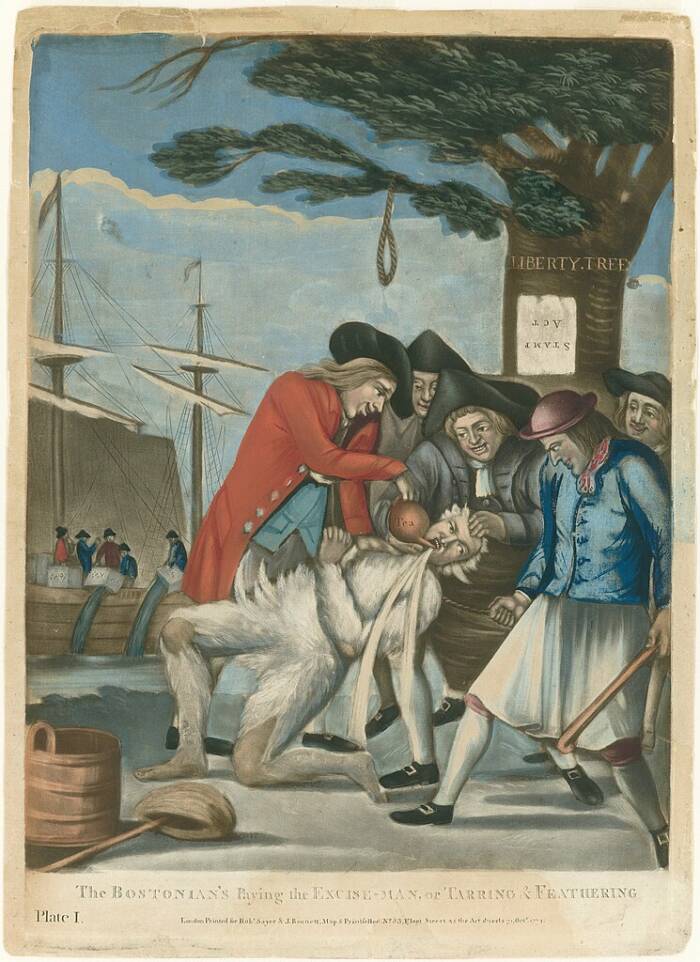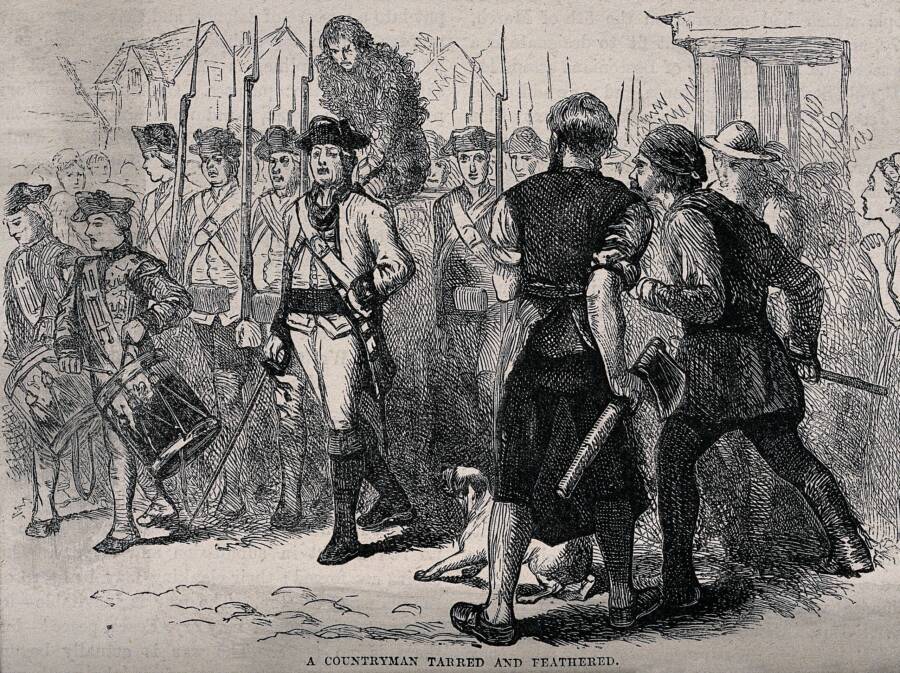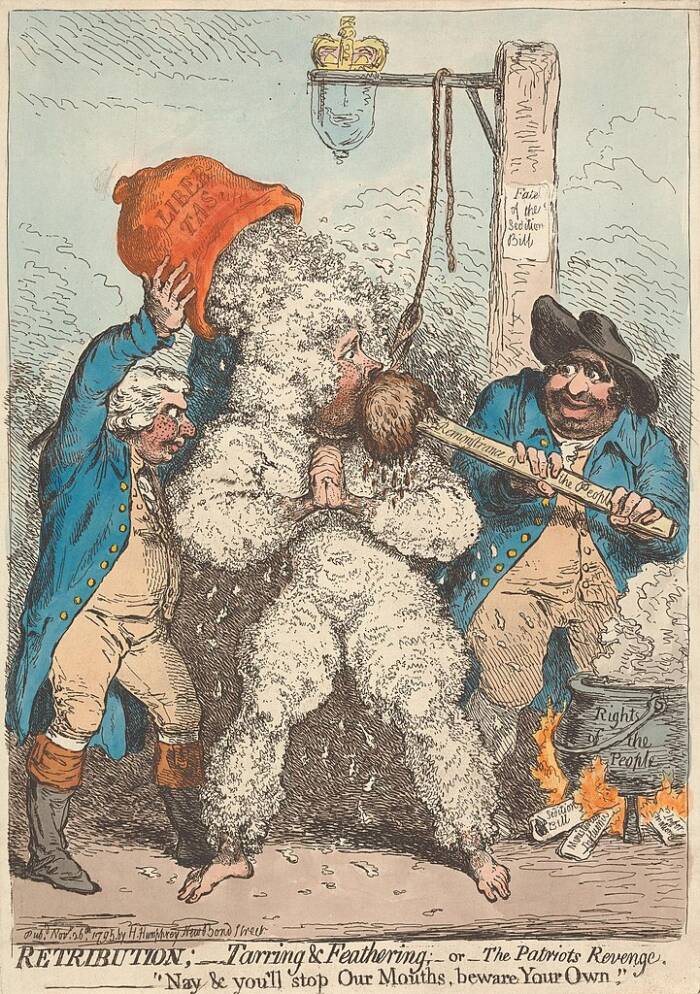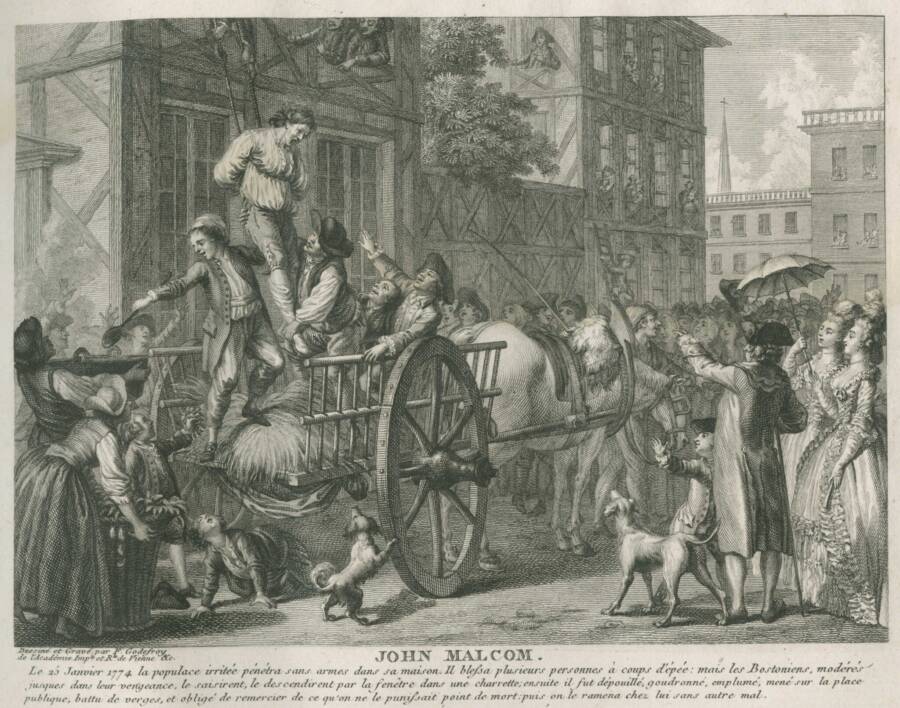Though tarring and feathering is closely associated with the vigilante justice of the American Revolution, it actually originated in the 12th century and was practiced throughout history.

Public DomainA depiction of the 1774 tarring and feathering of loyalist John Malcom in the lead-up to the American Revolution.
On a bitterly cold night in Boston in 1774, a crowd of angry Bostonians gathered around the pitiful figure of John Malcom, a 50-year-old customs agent and loyalist to the British Crown. They stripped him, poured hot tar and feathers over him, paraded him through town, and forced him to drink tea until he vomited.
This was one of the most infamous moments of someone being tarred and feathered in the days leading up to the American Revolution. But it was hardly unique. More than 70 loyalists suffered a similar fate.
That said, the history of tarring and feathering is hundreds of years older. And though this humiliating and cruel punishment is most closely associated with the American Revolution in the 18th century, it continued, on and off, long after British and American soldiers lay down their bayonets.
Discover the surprisingly long and shockingly brutal history of people being tarred and feathered.
The 12th-Century Origins Of Tarring And Feathering
Almost 600 years before John Malcom was dragged from his Boston home, Richard the Lionheart made the first documented reference to tar and feathering. In an 1189 proclamation about how to punish marauders discovered at sea, the English king declared:
“[He] shall be first shaved, then boiling pitch shall be poured upon his head, and a cushion of feathers shook over it so that he may be publicly known; and at the first land where the ships put in he shall be cast on shore.”
From there, tarring and feathering makes sporadic appearances in the historical record. A group of drunken friars and nuns were tarred and feathered in 1623 on the command of the Bishop of Halberstadt. Seventy years later, in 1696, an angry mob in London tarred and feathered a bailiff as he attempted to arrest a debtor.

Wellcome ImagesTarring and feathering was first documented in Europe in the 12th century.
But tarring and feathering really took off in the American colonies. In the 1760s and 1770s, it was frequently used as a form of torture and humiliation toward anyone who dared profess loyalty to the British Crown.
During The American Revolution
As the American Battlefield Trust notes, tarring and feathering in the American colonies was originally used to punish criminals. But it took on a different shape in the 1760s.
In 1765, tensions between the colonies and Great Britain skyrocketed after the passage of the hated Stamp Act. This attempt to raise taxes on the colonies resulted in widespread outrage, as well as disdain for so-called “loyalists” who remained faithful to the British Crown. The next year the first of these loyalists, a man named William Smith, was tarred and feathered after alerting royal authorities to contraband on a ship in Virginia.

Public DomainRetribution; – Tarring and Feathering; – or – The Patriots Revenge, – Nay You’ll Stop Our Mouths, Beware Your Own by James Gillray. 1795.
His tormentors also dropped him in the water, where Smith — coated in sticky pine tar and covered in feathers — almost drowned.
Over the next ten years, more than 70 other such incidents were reported throughout the American colonies. As the American Battlefield Trust explains, most tar and feather attacks followed a similar script. The victim, usually a loyalist, tax collector, or customs official, would be seized by a crowd, stripped, and covered in hot pine tar, which was used for waterproofing ships and could be found in abundance in port towns.
Next, the victim would be covered in feathers, which were sometimes lit on fire. Often they’d be beaten, whipped, and paraded through town.
Of all the dozens of tar and feather attacks that occurred in the decade before the American Revolution, perhaps the most shocking occurred in 1774 in Boston to a loyalist and customs agent named John Malcom. Incredibly, Malcom had been tarred and feathered the year before. Then, he’d seized a Sons of Liberty ship in Maine, arousing the wrath of local sailors.
This time, Malcom got into hot water — or hot pine tar — after berating a young boy riding on a sled. The commotion attracted the attention of George Hewes, a shoemaker and known patriot. The two men got into an argument, during which Malcom called Hewes a “vagabond” and Hewes retorted: “Be that as it will. I never was tarred and feathered anyhow.”
Malcom responded by hitting Hewes on the head with his cane, knocking the other man unconscious.
As word of Malcom’s attack spread, furious patriots besieged the loyalist’s Boston home. They dragged him into the street, stripped him, poured hot tar over his body, and covered him with feathers. Malcom’s attackers then whipped and beat him, and threatened to cut off his ears unless he cursed the king (which Malcom reluctantly did). Malcom was forced to drink tea until he vomited, then finally returned home dripping with tar and feathers.

Public DomainA depiction of the 1774 attack on John Malcom, a loyalist who hit a patriot with his cane.
“They say his flesh comes off his back in Steaks,” a witness recalled.
Malcom soon afterward fled to England, but the brutality of his attack was immortalized in a print, attributed to Philip Dawe, entitled: The Bostonians Paying the Excise-Man, or, Tarring & Feathering.
Such attacks began to wane around 1776, when the American Revolution began in earnest. But though tar and feathering is most closely associated with that conflict, it actually continued into the modern era.
The Modern History Of The Tar And Feather Punishment
After the Revolutionary War, tar and feathering continued to be used as a punishment and intimidation tactic. The British used it against the Irish in the Irish Rebellion of 1798, for example, and Mormon leader Joseph Smith was also tarred and feathered by an angry mob in 1832.
“They ran back and fetched the bucket of tar, when one exclaimed, with an oath, ‘Let us tar up his mouth;’ and they tried to force the tar-paddle into my mouth,” Smith later recalled of the attack. “All my clothes were torn off me except my shirt collar; and one man fell on me and scratched my body with his nails like a mad cat… My friends spent the night in scraping and removing the tar, and washing and cleansing my body… ”

Wikimedia CommonsJohn Meintz, a German American man who was tarred and feathered between 1917 and 1918 for refusing to support war bonds drives during World War I.
Even after Smith, everyone from Black Americans to suffragists to anti-war protestors have suffered a similar fate. Such attacks occurred in the 19th, 20th, and even the 21st centuries.
In 1918, during World War I, a German-American farmer living in Luverne, Minnesota named John Meintz was tarred and feathered after he allegedly refused to support a war bonds drive.
In 1971, Michigan high school principal R. Wiley Brownlee was kidnapped by KKK members and tarred and feathered for speaking at a school board meeting in favor of honoring Martin Luther King, Jr.
In 2007, an accused drug dealer in Belfast was tarred, feathered, and tied to a lamp post with the sign: “I’m a drug dealing scumbag.”
Thus, though people being tarred and feathered may seem like a relic of the American Revolution, this form of punishment and humiliation has a much longer history. From King Richard’s 12th-century decree to punishing drug dealers in 21st-century Ireland, tarring and feathering has stuck around for centuries.
After seeing how people came to be tarred and feathered throughout history, look through these surprisingly dark facts about America’s founding fathers. Or discover some of the most excruciating medieval torture methods.





